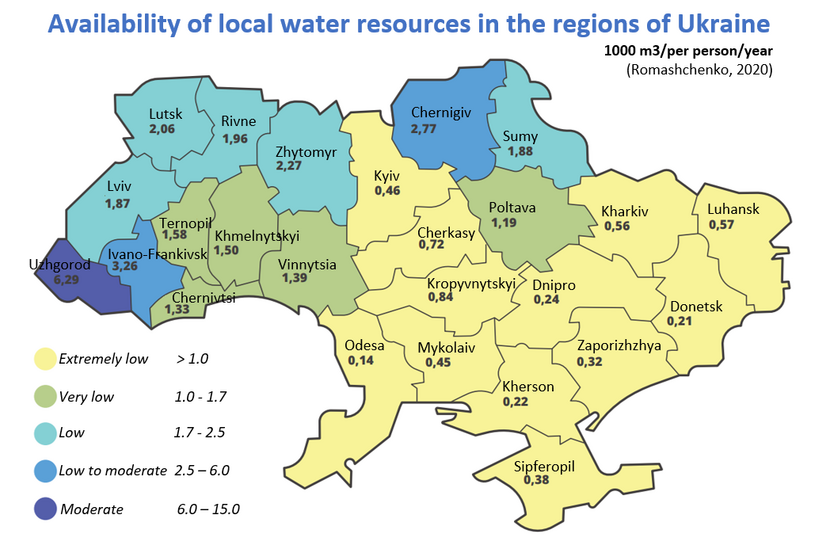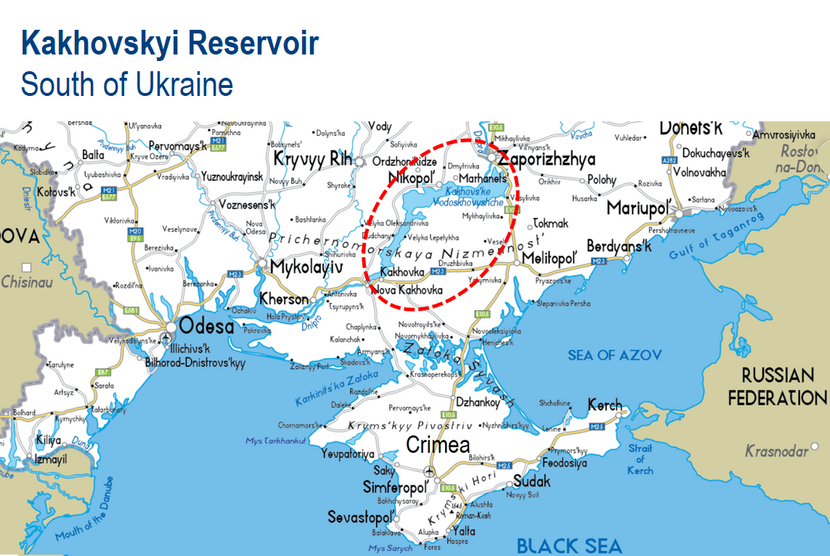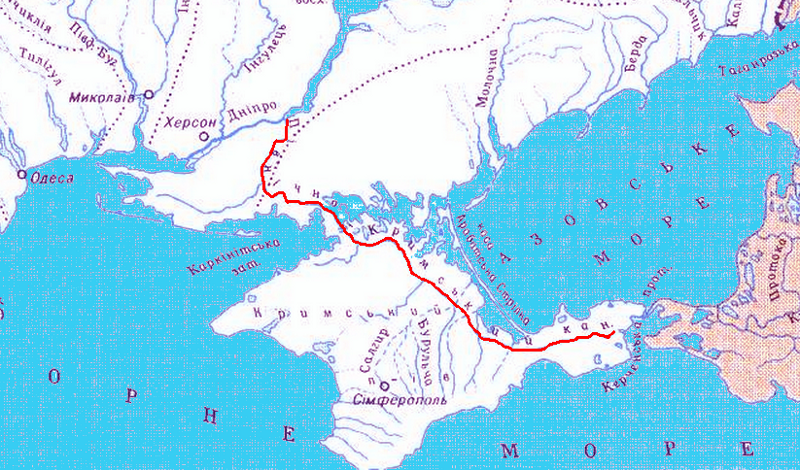Water security of Ukraine: war time and climate change
Historically, the climatic and geographical conditions of mainland Ukraine are favorable for the development of agriculture. However in 2019, Ukraine ranked 125th among 181 countries in the world in terms of available drinking water reserves. Even more problems are caused by climate change, and now by full-scale war.Currently twelve regions of Ukraine are already critically lacking water.
There are many rivers and lakes in Ukraine, and this creates the impression that the country is well supplied with water. However, most reservoirs are so polluted that the water from them cannot be used as drinking water or for irrigation. In 2019, Ukraine ranked 125th among 181 countries in the world in terms of available drinking water reserves. Even more problems are caused by climate change, and now by full-scale war. What is the situation with water in Ukraine now, let's find out below.

There is not enough water, and it is also being stolen
Historically, the climatic and geographical conditions of mainland Ukraine are favorable for the development of agriculture. Due to its intensity, this led to the highest percentage of plowed land in Europe — 53% — and to inefficient use of water resources. However, the climate is changing. Over the last 140 years, the average annual air temperature on Earth has increased by 1.1°С, in Ukraine this indicator has increased by 1.2°С only in the last 30 years. The higher the air temperature, the faster moisture evaporates from the soil and water resource. While the North and West of Ukraine are relatively well supplied with water, the water deficit in the center is 159–222 mm per year, and in the South it is more than 460 mm.
From the data shown in the picture, it can be seen that the Southern, Eastern and some Central regions of Ukraine are of critically shortage of water reserves. According to the study, the situation will only worsen due to climate change. These changes are already felt by farmers and affect the development of agriculture in Ukraine. In 2020, farmers lost part of their harvest due to the drought, the worst in Ukraine in the last 40 years. Last year, losses of winter wheat and barley amounted to about 50% of the amount harvested a year earlier. The corn harvest was completely lost on 203 000 hectares of sown land, and very low yields were obtained on 718 000 hectares. Thanks to the extensive irrigation system, which covered approximately 300 000 hectares, the Kherson Region reached its average yield that year. However, the proper operation of this system depends on the water balance of the Dnipro River and is related to the supply of water to the North Crimean Canal.

Water security in wartime
Russian aggression added new problems to Ukrainian agriculture: mined fields, polluted soil, destroyed or stolen agricultural machinery, sowing and harvesting took place under constant shelling. According to calculations by the Kyiv School of Economics, the repair and replacement of the irrigation infrastructure alone in the affected regions will cost 225 million USD.
An additional problem is illegal withdrawal of Dnipro water by the occupiers from the Kakhovka Reservoir and its supply to Crimea with violation of technological requirements. Back in March, the State Environmental Inspection of Ukraine very roughly estimated that the occupiers steal water for more than UAH 32 million per day, so as of mid-August, the amount of damages for the illegal supply of Dnipro water to the territory of the peninsula may have exceeded UAH 5 billion. It is impossible to fully assess the losses, because the Kakhovskaya HPP is still occupied.

These losses are not compensated by natural hydration. According to the Ukrhydrometeorological center, despite the rains and sometimes short showers, water levels in most rivers of Ukraine continued to decrease in July. The total volume of lateral inflow of water to the reservoirs of the Middle Dnipro in July was only 118 million cubic meters, which is 45% of the norm. Forecasts for the future are also disappointing. Even after the end of the war, the de-occupation of all Ukrainian lands and the restoration of the irrigation system due to climate change, the volume of fresh water in most river basins of Ukraine will continue to decrease. This means that the agriculture of our country will constantly experience a shortage of water, and therefore it is critically important to adapt it to climate change, taking into account the decrease in water content of rivers and the issue of water security in the region.

Crimean context: from dew to Dnipro water
Before the start of the North Crimean Canal (1963), most of the Crimean Peninsula (especially its Northern part) was not suitable for intensive agriculture due to the aridity of the climate. There are no large rivers on the territory of the peninsula, and those that exist are located in the Mountainous Crimea and the Southern coast of Crimea. Tobacco, grapes, apricots and some other fruits were grown there. In conditions of limited access to water, the local population had to be resourceful, so the Crimean Tatars had unique technologies for collecting water and using it rationally, which made it possible to grow fairly moisture-loving crops in arid regions. For example, in some areas, in order to irrigate fruit trees, they were lined with boulders, which cooled overnight, and in the morning, condensation - dew - collected on them. Due to the forced deportation of the Crimean Tatars by the Soviet authorities, most of the local traditional agricultural practices were lost.
The Soviet authorities were interested in the development of the Crimean peninsula as an agricultural region, so the construction of a canal began in 1957 to supply water from the Dnipro to irrigate fields where they had never been before. After the completion of construction, the North Crimean Canal provided 80–85% of the Crimean Peninsula's needs for fresh water, most of which was allocated to the needs of agriculture and helped to increase grain yields by at least sevenfold.
Even rice was cultivated in the North of Crimea, which requires a large volume of water. Accordingly, when the supply of Dnipro water to the temporarily occupied Crimea stopped in 2014, agriculture began to decline, and the area of irrigated land decreased 13 (!) times.
According to international humanitarian law, which protects the civilian population during war, ensuring the needs of people in the occupied territories is the sole responsibility of the occupying authorities. At the same time, in eight years, the occupation authorities in Crimea have not taken any steps to somehow take care of the region's water security. Instead, they actively began to use underground water, which led to salinization of groundwater and in some areas the upper soil layers.
On February 24, 2022, immediately after the start of the full-scale invasion, the Russian military seized the main construction of the North Crimean Canal and a few days later blew up the temporary dam and the main bulkhead structure of the canal to allow water into Crimea. Everything points to the fact that the restoration of water supply through the North Crimean Canal was one of the goals of Russia's full-scale invasion of Ukraine.
What to consider in post-war reconstruction
Therefore, water resources in Ukraine are threatened not only by the actions of the occupiers, but also by climate change. Scientists have calculated that just an increase in the average monthly temperature by 1°С, without taking into account other factors, leads to an increase in the potential total evaporation for a month by 9%. It is obvious that post-war reconstruction must take into account not only the consequences of hostilities and occupation, but also the negative impact of climate change.
Discussions and planning of the post-war reconstruction of Ukraine have already begun. The National Council presented the first version of the Plan for the recovery of Ukraine from the consequences of the war, which, in particular, defines adaptation to climate change as one of the five priority directions in the eco-security sector.
In order to reduce the impact of climate change on water supply, as well as to enable the development of agriculture in the future, the post-war reconstruction of Ukraine in this sector should include the following adaptation measures to climate change:
- choose agricultural crops with increased resistance to heat shock and droughts, change crop cultivation schedules in accordance with new climatic conditions;
- change irrigation methods, in particular the amount, timing and technologies used;
- introduce effective technologies for "harvesting" water, preserving soil moisture and reducing siltation and salinization;
- introduce the advanced technologies for cleaning and reuse of wastewater;
- improve water resources management to prevent waterlogging, erosion and soil leaching;
- diversify small and medium-sized agricultural enterprises, farms - this will simplify the process of introducing the best available technologies and practices.
After victory and de-occupation of Ukrainian lands, it will be necessary to restore a controlled and technically correct water supply to the Crimean Peninsula. It will also need to be taken into account when rebuilding agriculture, in particular, irrigation systems, in order to ensure the Crimeans' need for water and minimally affect the irrigation of fields in the regions dependent on the Kakhovsky Reservoir.
Sources
Institute of Water Problems and Land Reclamation and their Facebook page
Original article in Ukrainian (www.zn.ua) in UKR: https://bit.ly/3KCq7sZ
Scientific research 2020 by Romashchenko. In UKR. https://bit.ly/3Aif2bq
Analysis of the impact of climate changes on water resources of Ukraine. In UKR. EcoAction, 2021 https://bit.ly/3CIcRkn
Overview of war damage in Ukrainian agriculture. In UKR. KSE & Min Agro. 2022 https://bit.ly/3TlUO9z

We would like to invite the Dutch businesses to signal about their ideas and interest to contribute to the process of reconstruction on the webpage of the RVO. Bijdragen aan de wederopbouw (rvo.nl) and follow it for the updates.